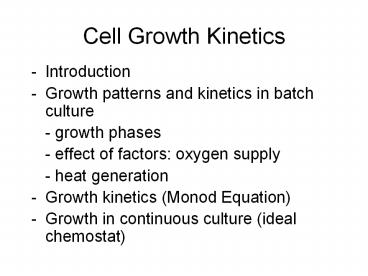Cell Growth Kinetics PowerPoint PPT Presentation
1 / 24
Title: Cell Growth Kinetics
1
Cell Growth Kinetics
- Introduction
- Growth patterns and kinetics in batch culture
- - growth phases
- - effect of factors oxygen supply
- - heat generation
- Growth kinetics (Monod Equation)
- Growth in continuous culture (ideal chemostat)
2
Growth Kinetics
Introduction - Autocatalytic reaction The rate
of growth is directly related to cell
concentration substrates cells ? extracellular
products more cells ?S X ? ?P nX S
substrate concentration (g/L) X cell mass
concentration (g/L) P product concentration
(g/L) n increased number of biomass. Net
specific growth rate (1/time) t the time
3
Growth Kinetics
Introduction Net specific growth rate
(1/time)
Gross specific growth rate (1/time)
The rate of loss of cell mass due to cell death
or endogenous metabolism
Endogenous metabolism during the stationary
phase, the cell catabolizes cellular reserves
for new building blocks and for energy-producing
monomers.
4
Growth Kinetics
Introduction Net specific replication rate
(1/time)
N Cell number concentration (cell number
/L)
5
Growth Kinetics
Introduction - Quantifying cell
concentration - direct no suspended solid
and interference compounds. cell mass
concentration preferred dry weight, optical
density (turbidity) (600-700nm Wave
Length) cell number density
Petroff-Hausser slide (hemocytometer), plate
counts, etc.
6
Growth Kinetics
- - Quantifying cell concentration
- - indirect direct method is inapplicable. (mold
solid state fermentation) - Cell mass can be determined by measurement of
protein, DNA or ATP. e.g. 1mg ATP/g dry weight
bacterial cell. - If 100 mg ATP/L is measured, then the cell mass
- 100 mg (ATP/L)/1 mg ATP/g dry cells100 (g dry
weight cells/L)
7
Growth Kinetics
- Growth patterns and kinetics in batch culture
- - growth phases
- In batch culture
- - lag phase
- - logrithmic or exponential growth phase
- - deceleration phase
- - stationary phase
- - death phase
8
Typical growth curve for a bacterial population
9
Batch Growth Kinetics
- Lag phase
- A period of adaptation for the cells to their new
environment - New enzymes are synthesized.
- A slight increase in cell mass and volume, but
no increase in cell number - Prolonged by low inoculum volume, poor inoculum
condition (high of dead cells), age of
inoculum, nutrient-poor medium - Multiple lag phases (diauxic growth) medium
contains more than one carbon source
10
Typical growth curve for a bacterial population
11
Typical growth curve for a bacterial population
12
Batch Growth Kinetics
- Exponential growth phase
- In this phase, the cells have adjusted to
their new environment and multiply rapidly
(exponentially) - Balanced growth all components of a cell grow
at the same rate. - Growth rate is independent of nutrient
concentration, as nutrients are in excess.
13
Batch Growth Kinetics
- Exponential growth phase
- The balance of cell mass in a batch culture gives
14
Typical growth curve for a bacterial population
15
Batch Growth Kinetics
- Exponential growth phase
Doubling time of cell mass the time required to
double the microbial mass
16
Typical growth curve for a bacterial population
17
Batch Growth Kinetics
- Deceleration growth phase
- Very short phase, during which growth decelerates
due to either - Depletion of one or more essential nutrients
- The accumulation of toxic by-products of growth
(e.g. Ethanol in yeast fermentations) - Period of unbalanced growth Cells undergo
internal restructuring to increase their chances
of survival
18
Typical growth curve for a bacterial population
19
Batch Growth Kinetics
- Stationary Phase
- With the exhaustion of nutrients (S0) and
build-up of waste and secondary metabolic
products - The growth rate equals the death rate.
- There is no net growth in the organism
population. - Cells may have active metabolism to produce
secondary metabolites. - Primary metabolites are growth-related ethanol
by S. cerevisae. - Secondary metabolites are non-growth-related
antibiotics, pigments.
20
Kinetic Pattern of Growth and Product Formation
Growth-associated
Non growth-associated
Mixed-growth-associated
21
Batch Growth Kinetics
- Stationary phase
- Cell lysis may occur and viable cell mass may
drop. - A second growth phase may occur and cells may
grow on lysis products of lysed cells (cryptic
growth) - Endogenous metabolism occurs by catabolizing
cellular reserves for new building blocks and
energy-producing monomer (maintenance energy). - The rate describing the conversion of cell mass
into maintenance energy or the loss of cell mass
due to cell lysis
22
Batch Growth Kinetics
- Death Phase
- The living organism population decreases with
time, due to a lack of nutrients and toxic
metabolic by-products. - The rate of death usually follows
23
Batch Growth Kinetics
Yield coefficients defined based on the amount
of consumption of another material.
24
Batch Growth Kinetics
Yield coefficients defined based on the amount
of consumption of another material. For most
bacteria and yeast Yx/s 0.4-0.6 g/g glucose
Yx/O20.9 1.4 g/g O2
At the end of the batch growth period, the
measured yields are apparent as of endogenous
metabolism occurring, Kd gt 0, which changes the
metabolic pathways of the substrate. e.g.

